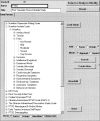WebEAV: automatic metadata-driven generation of web interfaces to entity-attribute-value databases
- PMID: 10887163
- PMCID: PMC61439
- DOI: 10.1136/jamia.2000.0070343
WebEAV: automatic metadata-driven generation of web interfaces to entity-attribute-value databases
Abstract
The task of creating and maintaining a front end to a large institutional entity-attribute-value (EAV) database can be cumbersome when using traditional client-server technology. Switching to Web technology as a delivery vehicle solves some of these problems but introduces others. In particular, Web development environments tend to be primitive, and many features that client-server developers take for granted are missing. WebEAV is a generic framework for Web development that is intended to streamline the process of Web application development for databases having a significant EAV component. It also addresses some challenging user interface issues that arise when any complex system is created. The authors describe the architecture of WebEAV and provide an overview of its features with suitable examples.
Figures




References
-
- 3M Health Information Systems. 3M Clinical Data Repository. Murray, Utah: 3M Corporation, 1998.
-
- Friedman C, Hripcsak G, Johnson S, Cimino J, Clayton P. A generalized relational schema for an integrated clinical patient database. Proc 14th Symp Comput Appl Med Care. 1990: 335-9.
-
- Johnson S, Cimino J, Friedman C, Hripcsak G, Clayton P. Using metadata to integrate medical knowledge in a clinical information system. Proc 14th Symp Comput Appl Med Care. 1990: 340-4.
Publication types
MeSH terms
Grants and funding
LinkOut - more resources
Full Text Sources
Other Literature Sources

